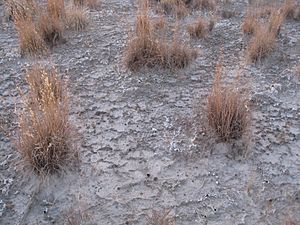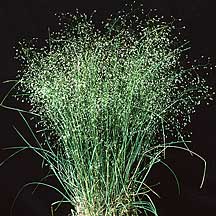Indian ricegrass facts for kids
Quick facts for kids Indian ricegrass |
|
|---|---|
 |
|
| Indian ricegrass growing in cryptobiotic crust at White Sands National Park | |
| Scientific classification | |
| Genus: |
Eriocoma
|
| Species: |
hymenoides
|
| Synonyms | |
|
Synonymy
Oryzopsis hymenoides Ricker ex Piper
Stipa hymenoides Roem. & Schult.(basionym) Eriocoma cuspidata Nutt. Oryzopsis cuspidata (Nutt.) Benth. ex Vasey Achnatherum hymenoides (Roem. & Schult.) Barkworth Eriocoma membranacea (Pursh) Beal 1896 not Steud. 1840 Fendleria rhynchelytroides Steud. Milium cuspidatum (Nutt.) Spreng. Oryzopsis membranacea (Pursh) Vasey Stipa membranacea Pursh Urachne lanata Trin. |
|
Eriocoma hymenoides is a type of grass often called Indian ricegrass or sand rice grass. It is a perennial plant, meaning it lives for more than two years. This grass has narrow, rolled leaves and grows naturally in western North America. You can find it from British Columbia and Alberta in Canada, all the way south to California, northeastern Mexico, and Texas.
Contents
What Does Indian Ricegrass Look Like?
In the wild, Indian ricegrass usually grows to be about 10 to 61 centimeters (4 to 24 inches) tall. It can also spread out to be about 20 to 30 centimeters (8 to 12 inches) wide. It's known for its thin, rolled leaves.
Where Does Indian Ricegrass Grow?
Indian ricegrass can grow in many different places. It thrives in dry areas like desert scrub and even in ponderosa pine forests. This grass is very tough and can grow in many types of soil, from sand to clay. It does especially well in sandy areas. In some sandy places, it is the main type of grass you will see, growing alongside plants like sagebrush. Indian ricegrass is also very good at holding sand in place, which helps stop sand dunes from shifting.
Why Indian Ricegrass is Important
Indian ricegrass is a very important food source for many animals. It helps feed farm animals like cattle and wild animals such as bison, desert bighorn sheep, elk, mule deer, pronghorns, and jackrabbits. It's especially helpful in late winter because it starts growing green shoots earlier than other grasses. Many small animals like rodents and birds, especially mourning doves, also eat its seeds.
This strong grass can grow back and spread easily in areas that have been damaged by fires or too much grazing. Many of its seeds sprout when April is wet. People also plant Indian ricegrass in xeriscape gardens, which are designed to use less water. If it has enough room, it can grow quite large. When it flowers or has seeds, it looks very pretty and sparkly, especially when the sun shines through it. Its flower stalks are often used in dry flower arrangements.
How People Use Indian Ricegrass
Long ago, Indian ricegrass was a very important food for Native Americans. They relied on it, especially if their maize (corn) crops didn't grow well. Tribes that didn't farm also used it. They would gather the seeds, grind them into flour, and then make bread.
More recently, since the year 2000, Indian ricegrass has been grown in Montana. It is sold as a gluten-free grain under the name Montina. The Zuni people also used the ground seeds as a main food source before they had corn.
Indian Ricegrass as a State Symbol
Indian ricegrass is so important that it has become a state symbol! In 1977, it was officially named the Nevada state grass. Later, in 1990, it became the state grass for Utah as well.
The Utah Section of the Society for Range Management started working to choose a state grass in the mid-1980s. After looking at many different types of grasses, they narrowed it down to four choices. These were Indian ricegrass, bluebunch wheatgrass, galleta grass, and Great Basin wildrye. They finally chose Indian ricegrass. A senator named Alarik Myrin, who was part of the Society, introduced the bill to make it the state grass in 1989.
See also
 In Spanish: Oryzopsis hymenoides para niños
In Spanish: Oryzopsis hymenoides para niños


